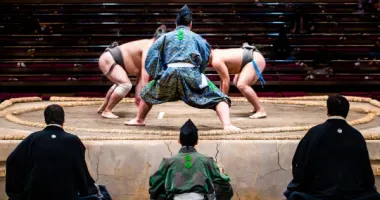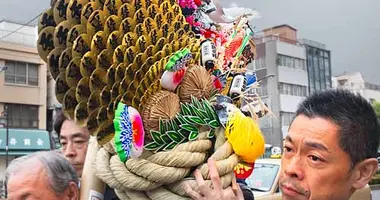Oeshiki and Ten Thousand Lights at Ikegami Honmonji Temple
Ikegami Honmonji Temple, Tokyo: people from Nichiren Buddhist temples all over Japan come to commemorate the death of the 13th century priest Nichiren.
Ikegami Honmonji Temple 池上本門寺 お会式
The tightly resonant drumming and the boisterous chanting could be heard almost the moment we got off the train at Nishi-Magome Station. It was Monday October 12, Physical Education Day--a national holiday--but something else was happening here.
In front of the Main Hall
Uchiwadaiko
It wasn't long before we saw our first procession of Buddhist faithful, in single file walking along the sidewalk each bearing an uchiwadaiko ("fan drum") which they beat in unison while loudly chanting the Lotus Sutra (or daimoku in Japanese): namu myoho renge kyo, namu myoho renge kyo! The group we encountered was one of many that converge on Ikegami Honmonji Temple on this day from Nichiren Buddhist temples all over Japan to commemorate the death of the thirteenth century priest Nichiren.

Mando lanterns
Oeshiki
Oeshiki (oh-eh-shee-kee) is the general name given to all commemorative festivals of a religious or other leader's death, but Oeshiki has come to be most closely associated to this event at Ikegami Honmonji. Groups of Nichiren Buddhist believers from thousands of Nichiren temples all over Japan come here. The members of each group sport distinctive happi coats and banners identifying their group.
Confectionery stall
The Ikegami Honmonji Oeshiki Festival climaxes after sundown, and besides the chanting and drumming features floats. Unlike the better known omikoshi floats used in Shinto festivals, the Oeshiki floats, called mando (literally, "ten thousand lights") are lantern-like structures with lights in the middle - often a lit-up miniature scale model of a pagoda - and are borne by groups of men up the 96 stone steps leading to the main temple building. At intervals, matoi: banner-type poles with tassels that firemen used to use as warning signals, are spun around so that the tassels radiate, the spinning being considered equivalent to reading sutras--not to mention the festive buzz the sight ignites.
Procession of believers in front of the temple
Nichiren Buddhism
Nichiren Buddhism is a very muscular form of Buddhism. Nichiren was strident in his criticism of other Buddhist interpretations during his lifetime, and Nichiren Buddhists were subject to much persecution because of the political implications and results of their beliefs and actions. Certain lay Nichiren Buddhists even took the teachings to the point of nationalist extremism in the late-19th to early-20th centuries in a movement known as Nichirenism. While Nichiren Buddhism, or any Buddhism for that matter, no longer plays such a conspicuous role in Japanese life today, the tradition of stridency is more than apparent in the powerful, almost martial, chanting and drumming that echoes through the streets and around the temple. Those uchiwadaiko, or "fan drums," may be very simple in construction, but the tension of the leather drumhead must be very high, because they sound they emit when beaten is remarkably loud, with a powerful tenor twang that is difficult to fully appreciate without hearing it live. That combined with the full-throated chanting that reminds you more of football crowd enthusiasm than religion (but perhaps that's a fine distinction?) make for a sound experience that you physically feel rather than just hear.
The Main Hall of Ikegami Honmonji Temple
Festival Stalls
However, inside the temple is more reminiscent of a party than a war. There are all the stalls you find at any Japanese festival, selling snacks, drinks, candy floss, toys, as well as booths for darts, fortune-telling and more--a cacophony of sellers' cries and kids' excited yells. The crowds are almost overwhelming. Tens, if not hundreds, of thousands of people gather for the Oeshiki, and there is very secure (but non-intrusive) crowd control in place, as well as fire engines on hand for the sake of the buildings.
Crowds pray at the main temple
Soshi-do
It is only when you approach the imposing Soshi-do (Founder's Hall) with a massive post planted in front of it bearing the daimoku, that the gravity and scale of the true celebration becomes clear. The numerous groups doing their circuits around the neighborhood come together in front of the 27-meter high Soshi-do where with renewed energy they chant and drum and clash small cymbals. Each then enters the temple group-by-group to receive a blessing, then makes way for the next group.
Visitors pay their respects at the temple
Meanwhile, a huge, deep-voiced gong sounds periodically over the courtyard and over the hubbub, reminding all of the solemnity of what is being commemorated. Aurally, that gong rung every minute or so was the most memorable thing about the whole experience for me, sounding right down deep and staying there, with eternity calling back during each strung-out interval.
The stupa with Nichiren's ashes
Ikegami Honmonji has numerous beautiful structures, made all the more alluring by dusk having fallen. Perhaps the most memorable was the red stupa containing the ashes of Nichiren himself, who was cremated here the day after his death. Adjoining the temple compound, on its west side, is Ikegami Baien (Ikegami Plum Tree Garden), a public park, with facilities including a lookout, and which provides a pleasant half-day diversion any time of the year. Ikegami Honmonji is accessible from Ikegami Station on the Tokyu Ikegami Line (about 10 minutes walk), Nishi-Magome Station on the Yurakucho subway line (15 minutes walk), or by Tokyu Bus to Honmonji-mae bus stop from either Omori or Kamata stations on the Keihin Tohoku Line.


























